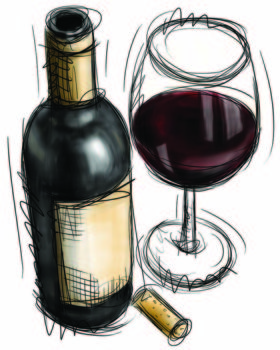Volcanic Wine
Volcanic Vino – Making wine from the ashes
Like all wine and winemaking traditions, volcanic wines combine a bit of the old with the new. People have long made wine from grapes grown in volcanic soil, but only recently have the distinctive attributes of these wines gained appreciation. Just as no two volcanoes are the same, neither are any two volcanic wines—or the regions, sub-regions or vineyards where they’re grown. The result is a wide variety of delicious offerings and a hot new trend in wine drinking.
A volcanic wine, simply put, is any wine from a region that’s experienced volcanic activity. That activity may have happened millions of years ago, as is the case with parts of California’s Napa Valley, or it may have occurred much more recently, as with Mt. Etna in Sicily. The slopes of this very active volcano are home to dozens of wine growers, who shrug off obvious danger to take advantage of the mineral-rich black soil that has made the Etna wine region one of the most exciting in Italy. With volcanic soils covering 124 million hectares (just under 1 percent of Earth’s land surface), regions all over the world are following suit. Some notable examples include Soave in northeastern Italy, Santorini in Greece and the Willamette Valley in Oregon.
The key, of course, is the ashy soil. Highly porous, volcanic ash retains a great quantity of water and air, which keep grapevines nourished and hydrated. Soil is also key to the wine’s flavour. The minerals and nutrients left behind by flowing lava make the soil structure in each volcanic region unique, imparting distinctive flavours and aromas in the wines produced there. Combined with other environmental factors, like altitude and climate, soil helps to create a wine’s terroir, or “sense of place.” While this is true of all wine, terroir is especially important to volcanic wines and is part of the charm of the volcanic trend.
According to Karem El-Halaby of Lacombe Park Spirits in St. Albert, the effect of soil and other factors means volcanic wines cover a range of flavour profiles. “They can be light, elegant, and much less tannic [than regular wine],” he says, “as well as heavier, richer and earthy.” Though there’s no such thing as a typical flavour profile, volcanic wines are often described as aromatic and savoury, with an intense mineral finish.
Prices can also vary considerably, as they do with regular wines. The cheapest bottles will start at around $15, and a very good selection can be found between $25 and $65. And if you’ve got an extra mortgage payment (or three) burning a hole in your pocket, “you could spend up to $2,300 for a beautiful bottle of Marsala from Sicily,” notes El-Halaby.
Ready to find a bottle? Well, that could be a little tricky—but not for lack of inventory. Since volcanic wine is not yet recognized as its own category or style of wine, you generally won’t find a designated section at your local liquor store. And, in most cases, reading the label won’t help either because wineries usually don’t indicate that their wines are from a volcanic region. But fear not. Asking for help yields results, and you might even discover you’ve been buying and enjoying volcanic wine for years without being aware of it. As El-Halaby explains, “Clients continually request wines from these regions, but not specifically for the reason that they are from vineyards with volcanic soil conditions.”
Wine enthusiasts can also do some research on their own. Fortunately, as volcanic wines become trendier, word continues to spread. Many wine bloggers have written about volcanic wine, making information and recommendations easy to find online. Several books on the subject have also appeared recently, including Volcanic Wines: Salt, Grit and Power, by Canadian sommelier John Szabo. Finally, knowledgeable wine sellers can help. As El-Halaby puts it, “It is our responsibility to educate our clients about these regions and their wines.” The volcanic wine tradition may finally be getting its due.
Three Wines to Try If you’re interested in sampling volcanic wine, El-Halaby recommends these affordable choices:
Sokol Blosser Delinea 300 Pinot Noir
From the Willamette Valley in the Pacific Northwest, a cool-climate region renowned for its Pinot Noir. Grown at an altitude of 300 metres, where two soil types converge. Elegant and earthy, packed with fruit flavours such as raspberry and cherry. Pairs well with grilled salmon, turkey or pork tenderloin.
$27.99
Boutari Santorini Assyrtiko
A white wine made from the Assyrtiko grape, which is native to Santorini, Greece. Aromas of green apple and citrus fruits, with an acidic, full-bodied taste and a lingering finish. A great choice with seafood or white meat, especially chicken.
$21.99
Planeta Eruzione 1614 Nerello Mascalese
From Mt. Etna, this Italian red wine is made entirely from the indigenous Nerello Mascalese grape variety. Mt. Etna’s longest recorded eruption began in 1614 and lasted 10 years. A light, luminous ruby red with aromas of herbs, incense and rose. Elegantly tannic, with candy and wild berry flavours. Can be paired with cheese and salami or with more complex fish or game dishes.
$37.99
More Like This
6 Surprising Local Ice Cream Flavours
Read
Donairs & Shawarmas
Read
Green Onion Cakes
Read






